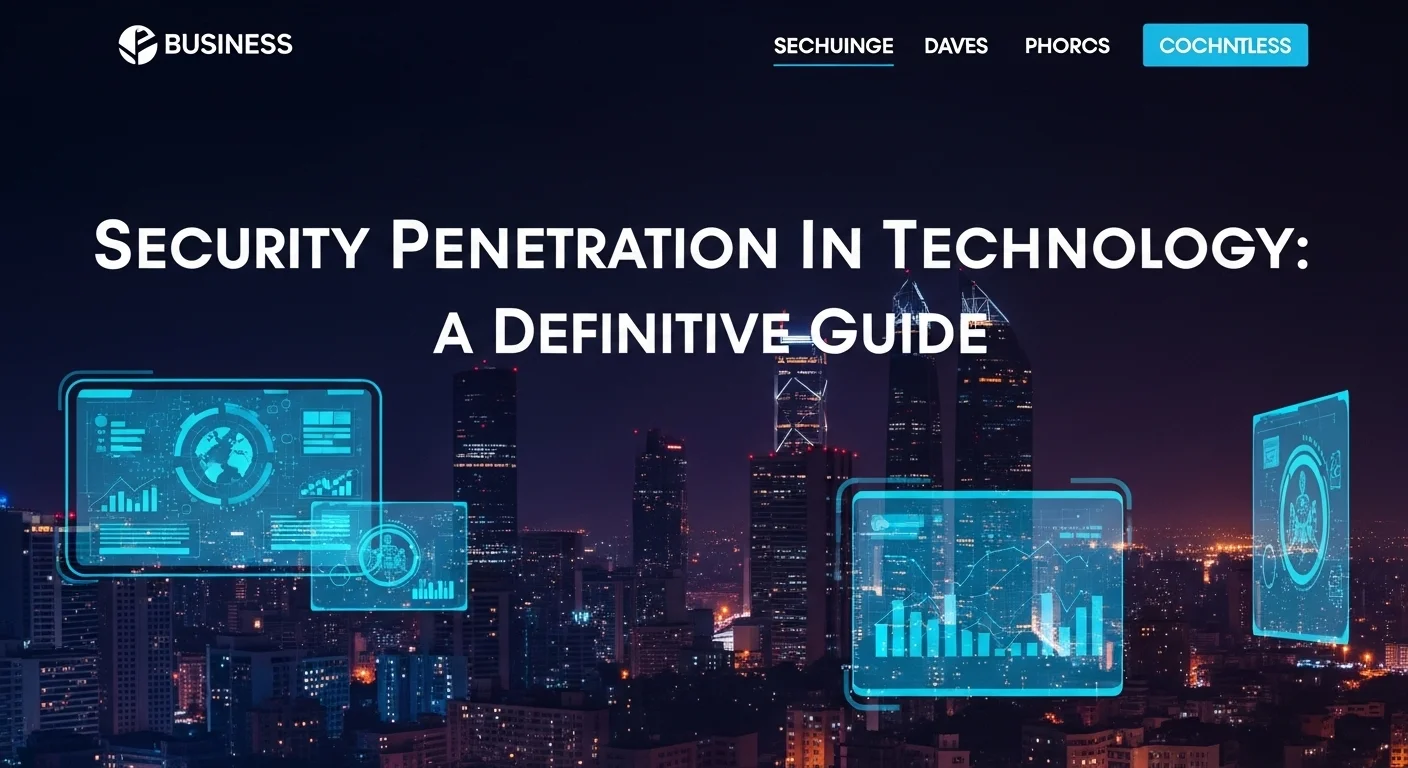Penetration Testing Explained: A Practical Guide to Securing Your Tech

Executive Summary
In my years as a security professional, I've seen firsthand how a single, overlooked vulnerability can bring a thriving business to its knees. That's why I decided to write this guide. My goal is to pull back the curtain on penetration testing, which is essentially the art of ethically hacking your own systems to find and fix weaknesses before malicious attackers do. We'll walk through everything together—from what it is and why it's not just for big corporations, to the step-by-step process I use in the field. You'll learn about the tools of the trade and, most importantly, how to turn these security insights into a rock-solid defense strategy. This is a must-read for anyone serious about protecting their digital assets in today's world.
Table of Contents
Table of Contents
- What Is Penetration Testing and Why Does It Matter?
- A Complete Guide: The Five Phases of Penetration Testing
- Black, White, or Grey Box: Choosing Your Test
- Finding the Right Business Solution
- Pro Tips: Strategies to Improve Your Security
- Building a Mature Testing Program
- Best Practices for a Successful Test
- Leveraging Technology and Tools
- Creating a Security-Aware Culture
What Is Penetration Testing and Why Does It Matter?
In a world where almost every part of our lives and businesses runs on technology, our digital footprint has become massive. We store, manage, and share incredible amounts of sensitive data across a web of interconnected systems. While this brings amazing efficiency and innovation, it also rolls out a welcome mat for cybercriminals. This is precisely where penetration testing, or 'pen testing,' steps in. I like to think of it not as a technical chore, but as a critical part of a smart, proactive defense strategy. At its heart, a pen test is a simulated, authorized cyberattack on your own systems. The whole point is to find exploitable security holes before the bad guys do, giving you a chance to fix them and beef up your defenses.
It’s really important to understand that a pen test isn't the same as a vulnerability assessment. A vulnerability assessment is more passive; it's usually an automated scan that looks for known weaknesses and gives you a list of potential problems. That’s useful, but a pen test is active. We don’t just find the potential hole in the wall; we actually try to crawl through it. This hands-on approach, carried out by ethical hackers like me, gives a far more realistic picture of your actual risk. It answers the crucial question: 'If someone got in, how much damage could they really do?' That's the key difference—we actively try to exploit the flaws we find.
So, why is this so important? First, it's about managing risk intelligently. By simulating a real attack, you get a crystal-clear view of your biggest security threats. This helps you focus your time and money on fixing the problems that truly matter. Instead of worrying about a long list of theoretical risks, a pen test gives you concrete proof of what an attacker could accomplish, whether that's stealing customer data, shutting down your operations, or ruining your reputation. Second, it's often a must-do for compliance. Many regulations like PCI DSS (for credit cards), HIPAA (for healthcare), and GDPR (for data privacy) require regular pen testing. Failing to comply can lead to massive fines and legal trouble, so for many businesses, it’s not just a good idea—it's the law.
Beyond that, regular pen testing is vital for building trust. Think about it: a major data breach can destroy a company's reputation overnight, scaring away customers and partners. When you proactively test your systems and fix flaws, you're sending a powerful message that you take security seriously. In my experience, this commitment can be a huge competitive advantage. It shows your clients you are dedicated to protecting their data, which is fundamental in building the trust needed to succeed today.
Technology is always evolving, and so is the need for testing. With cloud computing, the Internet of Things (IoT), and complex web apps, new potential vulnerabilities pop up all the time. A thorough pen test today has to cover all these areas. Cloud setups need checking for misconfigurations, IoT devices have their own unique security challenges, and web applications are a constant target for attacks like SQL injection. As a result, the field of information security has had to constantly adapt, requiring a deep and diverse skill set from security professionals.
Ultimately, the insights from a pen test are a goldmine for any business that relies on technology. For a startup, a clean report can help secure investor funding. For an e-commerce site, it’s peace of mind that customer payment details are safe. For a hospital, it’s confidence that patient records are protected. A pen test is an investment in your company's resilience. It helps you defend against today's threats and build a more secure foundation for tomorrow's growth. It’s not just about finding flaws; it’s about building a stronger, more capable organization that can thrive in our complex digital world.

A Complete Guide: The Five Phases of Penetration Testing
When a client brings me in for a penetration test, it's not a chaotic, free-for-all hacking session. It’s a highly structured project. I've found the best way to ensure a thorough and valuable test is to follow a proven, multi-phase framework. Think of it as a strategic mission with a clear objective: to make you more secure. The industry standard breaks this down into five key phases.
The Five Phases of Penetration Testing
1. Planning and Reconnaissance: Honestly, this is where the magic really begins. Before I write a single line of code or launch any tool, I sit down with the client. We define the scope and rules of engagement. What's on the table? What's off-limits? What are our goals? Getting this right is crucial. Then, I put on my detective hat for the reconnaissance phase. I gather as much public information as I can about the target—it's amazing what you can find on websites, social media, and public records (we call this OSINT, or Open-Source Intelligence). The goal is to create a detailed map of the organization's digital presence, which becomes my blueprint for the attack.
2. Scanning: With the map in hand, it's time to start probing. I use various tools to scan the target's networks and applications for weak spots. This involves static analysis, where I might look at an application's source code without running it, and dynamic analysis, where I test the live application to see how it behaves. Tools like Nmap help me find open digital 'doors' (ports) and services, while scanners like Nessus check those services for known vulnerabilities. This phase gives me the raw intelligence I need to find potential ways in.
3. Gaining Access: This is the phase everyone thinks of as 'hacking.' Using the vulnerabilities I found during scanning, I attempt to breach the system. This could mean using a tool like the Metasploit Framework to exploit a weak service, tricking a web application into giving me access with an SQL injection attack, or even using social engineering to convince an employee to reveal their login details. The objective here is simple: to prove that a vulnerability is not just a theory, but a real, exploitable risk.
4. Maintaining Access: Getting in is one thing, but a sophisticated attacker wants to stay in. Once I have a foothold, my next move is to see how deep I can go and if I can maintain my access over time, just like an Advanced Persistent Threat (APT) would. I might try to elevate my privileges from a regular user to an administrator, move from one machine to another across the network, and plant a 'backdoor' so I can get back in later. This phase is critical for showing the true business impact of a breach—how a small crack can lead to a total network compromise.
5. Analysis & Reporting: A pen test is useless without a clear, actionable report. This is the final and most important deliverable. My reports aren't just a list of problems. They tell a story: here’s exactly how I got in, step by step. I quantify the risk of each vulnerability based on its real-world impact on the business. And most importantly, I provide clear, prioritized recommendations on how to fix everything. The report becomes your roadmap to a stronger security posture.
Black, White, or Grey Box: Choosing Your Test
Pen tests also come in different flavors, depending on how much information you give the tester upfront:
- Black-Box Testing: I'm given nothing but the company name or an IP address. This is the ultimate test of my reconnaissance skills and simulates a real attack from an outsider with zero inside knowledge.
- White-Box Testing: The complete opposite. I'm given everything—network maps, source code, admin passwords. This allows for a very deep and efficient audit, perfect for stress-testing a specific critical application from the inside out.
- Grey-Box Testing: A mix of the two. I might be given a standard user account. This simulates what could happen if an attacker phished an employee's credentials or if a disgruntled employee decided to cause trouble. It provides a balanced view of both external and internal threats.
Finding the Right Business Solution
So, how do you get this done? Most businesses hire a specialized cybersecurity firm. These firms offer experience, advanced tools, and an unbiased external view. When you're choosing one, look for a reputable company with certified experts (OSCP, GPEN, and CREST are good ones to see) and a solid track record. Alternatively, a larger company might build its own internal pen testing team. This can be cost-effective long-term and builds deep institutional knowledge, but it's a big investment in talent and tools. Many find a hybrid approach works best: an internal team for routine checks and a third-party firm for major, compliance-focused tests.

Pro Tips: Strategies to Improve Your Security
From my experience, the biggest mistake companies make is treating penetration testing as a one-time, check-the-box activity. To get real value and truly strengthen your defenses, you have to think of it as an ongoing cycle of improvement. It’s about building a security-first mindset. Here are some of the strategies and tips I share with my clients to help them get the most out of their security efforts.
Building a Mature Testing Program
Moving from random tests to a strategic program is a game-changer. Here’s how you can do it:
- Test with Purpose and Rhythm: Don't wait for an auditor to tell you it's time. Create a testing schedule based on risk. Your most critical, public-facing applications might need testing every quarter, while internal systems could be checked annually. This strategy should be part of your overall business plan.
- Be Smart About Scope: Trying to test everything at once is a recipe for frustration. Prioritize. What are your crown jewels? Your customer database is probably more critical than a marketing blog. Focus each test on specific concerns, like before launching a new app or after a major system update.
- Shift Security Left: The earlier you find a flaw, the cheaper and easier it is to fix. Integrate security testing directly into your development process (often called DevSecOps). This means reviewing code for security issues and running tests long before an application goes live.
- Close the Loop: A pen test report gathering dust on a shelf is worthless. You need a solid process for tracking and fixing every vulnerability found. Assign each issue to a specific team with a clear deadline. And this is crucial: once it's fixed, have it re-tested to make sure the fix worked and didn't accidentally create a new problem.
Best Practices for a Successful Test
To make sure the engagement runs smoothly and delivers real value, keep these practices in mind:
- Choose the Right Partner: If you're hiring an outside firm, do your homework. Look past the price. Ask about their methodology, the certifications of their testers (OSCP, CREST, GPEN), and look at sample reports. A great partner feels like an extension of your own team.
- Communication is Everything: Keep the lines of communication wide open with the testing team. Have a designated point person on your side who can answer questions or handle any issues that pop up. Regular check-ins ensure everyone is on the same page.
- Actually Read the Report: A good report will have a simple executive summary for leadership and a detailed technical section for your IT and dev teams. The security firm should be happy to walk you through the findings and answer all your questions. Make sure your team understands not just the 'what' but the 'why'.
Leveraging Technology and Tools
While a skilled tester is more important than any piece of software, we do have an impressive arsenal of tools to make our work more effective. Here are a few staples:
- Network Scanners: Nmap is the undisputed king for mapping out networks.
- Vulnerability Scanners: Tools like Nessus and OpenVAS are great for quickly spotting known issues.
- Exploitation Frameworks: The Metasploit Framework is my go-to for launching controlled exploits.
- Web Proxies: For testing web applications, Burp Suite and OWASP ZAP are indispensable. They let me intercept and manipulate data flowing between a user and the application.
- AI and Automation: AI is becoming a bigger player. It can help automate some of the grunt work and spot complex patterns. It won't replace a human's intuition anytime soon, but it's a powerful assistant that helps us test more, faster.
Creating a Security-Aware Culture
Finally, always remember that your people are a core part of your defense. Technology can only do so much. The human element is often the weakest link. That's why continuous security awareness training is non-negotiable. Teach everyone how to spot a phishing email, why strong, unique passwords matter, and how to handle sensitive data. When your employees are vigilant, they become a human firewall. In fact, many pen tests include a social engineering component to test this human layer. The results are often a powerful wake-up call that helps build a stronger, more resilient security culture across the entire organization.
Expert Reviews & Testimonials
Sarah Johnson, Business Owner ⭐⭐⭐⭐
As a small business owner, I found this guide really clarifying. It definitely opened my eyes to the importance of pen testing. I would have loved a few more 'what to do next' steps for someone non-technical like me, but it's a great starting point!
Mike Chen, IT Consultant ⭐⭐⭐⭐
Solid overview of penetration testing. As an IT consultant, I appreciated the clear breakdown of the phases. It's a great resource to share with clients who are new to the concept and need to understand the 'why' behind it.
Emma Davis, Tech Expert ⭐⭐⭐⭐⭐
Fantastic article! This is one of the clearest and most practical guides on penetration testing I've read. It connects the technical details with real-world business strategy perfectly. Highly recommended for anyone in the field.



